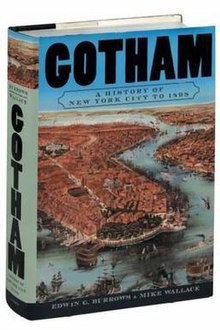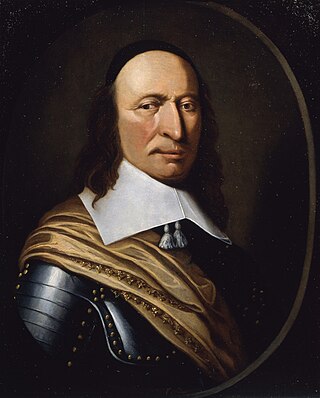
Peter Stuyvesant was a Dutch colonial officer who served as the last Dutch director-general of the colony of New Netherland from 1647 until it was ceded provisionally to the English in 1664, after which it was split into New York and New Jersey with lesser territory becoming parts of other colonies, and later, states. He was a major figure in the early history of New York City and his name has been given to various landmarks and points of interest throughout the city.

The written history of New York City began with the first European explorer, the Italian Giovanni da Verrazzano in 1524. European settlement began with the Dutch in 1608 and New Amsterdam was founded in 1624.

Mike Wallace is an American historian. He specializes in the history of New York City, and in the history and practice of "public history". In 1998 he co-authored Gotham: A History of New York City to 1898, which in 1999 won the Pulitzer Prize in History. In 2017, he published a successor volume, Greater Gotham: A History of New York City from 1898 to 1919. Wallace is a Distinguished Professor of History at John Jay College of Criminal Justice, and at the CUNY Graduate Center.
Edwin G. "Ted" Burrows was a Distinguished Professor of History at Brooklyn College. He is the co-author of the Pulitzer Prize-winning Gotham: A History of New York City to 1898 (1998), and author of Forgotten Patriots: The Untold Story of American Prisoners During the Revolutionary War, (2008), which won the 2009 Fraunces Tavern Museum Book Award.
The history of New York City (1855–1897) started with the inauguration in 1855 of Fernando Wood as the first mayor from Tammany Hall, an institution that dominated the city throughout this period. Reforms led to the New York City Police Riot of June 1857. There was chaos during the American Civil War, with major rioting in the New York Draft Riots. The Gilded Age brought about prosperity for the city's upper classes amid the further growth of a poor immigrant working class, as well as an increasing consolidation, both economic and municipal, of what would become the five boroughs in 1898.
Beginning on July 7, 1834, New York City was torn by a huge antiabolitionist riot that lasted for nearly a week until it was put down by military force. "At times the rioters controlled whole sections of the city while they attacked the homes, businesses, and churches of abolitionist leaders and ransacked black neighborhoods."

The Academy of Music was a New York City opera house, located on the northeast corner of East 14th Street and Irving Place in Manhattan. The 4,000-seat hall opened on October 2, 1854. The review in The New York Times declared it to be an acoustical "triumph", but "In every other aspect ... a decided failure," complaining about the architecture, interior design and the closeness of the seating; although a follow-up several days later relented a bit, saying that the theater "looked more cheerful, and in every way more effective" than it had on opening night.

The Astor House was a luxury hotel in New York City. Located on the corner of Broadway and Vesey Street in what is now the Civic Center and Tribeca neighborhoods of Lower Manhattan, it opened in 1836 and soon became the best-known hotel in America. Part of it was demolished in 1913; the rest was demolished in 1926.

The United Charities Building, also known as United Charities Building Complex, is at 105 East 22nd Street or 287 Park Avenue South, in the Gramercy Park neighborhood of Manhattan, New York City, near the border of the Flatiron District. It was built in 1893 by John Stewart Kennedy, a wealthy banker, for the Charity Organization Society. It was designated a National Historic Landmark in 1991 for the role the Charity Organization Society played in promoting progressive social welfare policies, including the development of academic disciplines in that area.

Salmagundi; or The Whim-whams and Opinions of Launcelot Langstaff, Esq. & Others, commonly referred to as Salmagundi, was a 19th-century satirical periodical created and written by American writer Washington Irving, his oldest brother William, and James Kirke Paulding. The collaborators produced twenty issues at irregular intervals between January 24, 1807 and January 15, 1808.
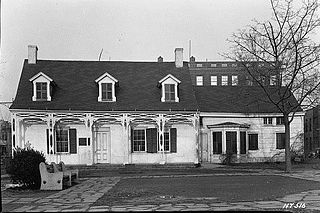
Van Pelt Manor was the name given to an area of Brooklyn, New York, that today is part of the section of Bensonhurst. In the early part of the 20th century, it gave its name to a railroad station, a post office, and Public School 128 was known as Van Pelt Manor grammar school. The house purchased or raised by Aert Teunisse Van Pelt about 1670-1690 stood on modern-day 18th Avenue between 81st and 82nd Streets, east of the old village square and north of the pre-revolutionary Dutch Church of New Utrecht.

University Place is a short north-south thoroughfare in the Greenwich Village neighborhood of Manhattan, New York City, United States, which runs from Washington Square Park in the south as a continuation of Washington Square East, taking the position of Madison Avenue uptown, and terminates at East 14th Street just southwest of Union Square. Although the roadway continues north of 14th Street as Union Square West, traffic on the two streets run in opposite directions, both feeding into 14th Street. Until the late 1990s, University Place was a two-way street. The street contains numerous cafes, shops, and restaurants, many of which cater to students at NYU and The New School.

The Jerome Mansion was a mansion on the corner of East 26th Street and Madison Avenue, across from Madison Square Park, in the modern NoMad neighborhood of Manhattan in New York City. It was the home of financier Leonard Jerome, one of the city's richest and most influential men in the middle- to late-19th century. It was built from 1859 to 1865 and demolished in 1967.
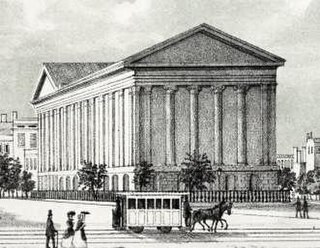
The Astor Opera House, also known as the Astor Place Opera House and later the Astor Place Theatre, was an opera house in Manhattan, New York City, located on Lafayette Street between Astor Place and East 8th Street. Designed by Isaiah Rogers, the theater was conceived by impresario Edward Fry, the brother of composer William Henry Fry, who managed the opera house during its entire history.
Peter Delanoy, who served from 1689 to 1691, was the first and only directly elected Mayor of New York City until 1834. Appointed mayors resumed in the wake of Leisler's Rebellion. He was succeeded by former Mayor John Lawrence.
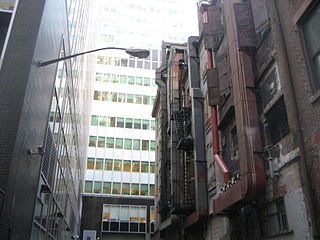
Marketfield Street is a short one-way, one-block-long alleyway in the Financial District of Manhattan, New York City. The street begins as a southern branch of Beaver Street, then veers east and north, ending at Broad Street. Alternative past names include Exchange Street, Field Street, Fieldmarket Street, Oblique Road, and Petticoat Lane.
The Bread and Cheese Club was a New York City-based intellectual group.
The New York Daily Sentinel, founded in 1830, was one of the first daily newspapers in the United States. It was founded by Benjamin Day, Willoughby Lynde, and William J. Stanley. Its publishers were Lynde, Stanley & Co., the Association of Working Men, and George H. Evans.
The Long Bridge Boys were one of two early gangs formed in New York that participated in the Conspiracy of 1741. Their name either came from the Coffee House Bridge near the end of Wall Street, or the bridge at the foot of Broad Street over the sewer.
